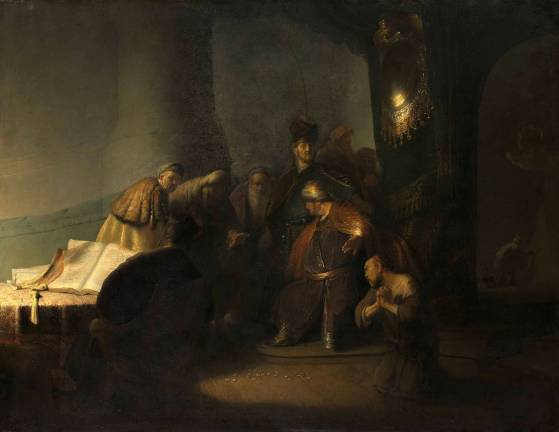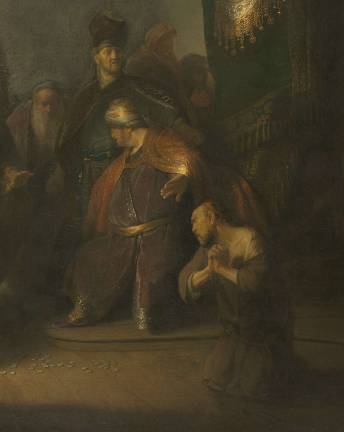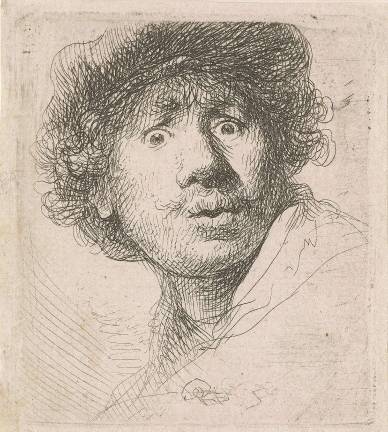Rembrandt’s Grieving Judas



BY VAL CASTRONOVO
In 1629, Constantijn Huygens, a Dutch diplomat and art advisor to the Prince of Orange, paid a visit to Rembrandt van Rijn and Jan Lievens, two prodigies sharing a studio in Leiden, a university town in the Dutch Republic. His opinions are now the stuff of legend, dutifully recorded in an autobiographical manuscript, on loan this summer from the Royal Library at The Hague for an exquisite presentation at The Morgan, “Rembrandt’s First Masterpiece.”
A showcase for the rarely seen biblical painting, “Judas Returning the Thirty Pieces of Silver” (1629), the exhibit also includes drawings and etchings of the Gospel narratives and five early self-portraits. The Morgan owns hundreds of drawings and prints by Rembrandt (1606-1669), a world-renowned collection started by Pierpont Morgan in 1900.
Considered his first mature work, or masterpiece, the Judas painting, now in a British private collection, floored Huygens when he first saw it. As he later enthused in Latin in his autobiography, a jewel that graces the entrance to the show: “Rembrandt ... devotes all his loving concentration to a small painting, achieving on that modest scale a result which one would seek in vain in the largest pieces of others. I cite as an example his painting of the repentant Judas returning to the high priest the silver coins which were the price for our innocent Lord. Compare this with all Italy, indeed, with all the wondrous beauties that have survived from the most ancient of days ... All honor to thee, Rembrandt!”
The Dutch master, the son of a miller, was only 23 when he completed the panel, which bears all the hallmarks of his later history paintings: the depiction of an emotional scene; light and shadow; dark colors; expressive faces; expressive hands, which, for Rembrandt, are like faces; exotic costumes; gleaming metals; and, perhaps most tellingly, an asymmetrical arrangement of figures, who lean in to the action.
“The viewer is being invited in,” docent Miryam Wasserman said on a recent afternoon tour. “He opens a door to a dramatic moment.”
Judas has come begging for forgiveness for his kiss of betrayal and thrown the bribe money — 30 silver coins — to the floor of the temple. Look at the painting and count them. They glisten. The chief priest, flanked by elders, is disdainful of the gesture and uses his hand to repel the kneeling figure. Huygens captures the drama, writing, “that one maddened Judas … his gaze wild, his hair torn out by the roots, his garments rent, his arms contorted, his hands clenched until they bleed; a blind impulse has brought him to his knees, his whole body writhing in pitiful hideousness.” (Footnote: The grieving Judas later hangs himself for betraying Christ.)
The story of the scene in the temple is only recorded in one of the four Gospels, Matthew 27:3–5; the verses are quoted on an exhibit board adjacent to the painting. What gives the show special bragging rights is the inclusion of five preparatory drawings, reunited with the painting for the first time since they were in the master’s studio. The Judas panel is one of the rare Rembrandt paintings for which so many preparatory works survive.
As Holm Bevers, a curator at Berlin’s Museum of Prints and Drawings, writes in the catalog, Rembrandt’s approach to painting was “not systematic” like that of contemporary Peter Paul Rubens: “One possible explanation for this unusual and unexpected scarcity of drawings can be found in Rembrandt’s working method: technical examination of his paintings has shown little evidence of preparatory drawings beneath the paint; Rembrandt seems to have painted directly onto the prepared canvas or panel.”
And, as X-ray photos and study of the surface of the Judas painting reveal, he revised substantially as he went along. He would even go back to his preparatory drawings while in the process of painting to “work out problems,” Wasserman said.
Rembrandt may have been a miller’s son, but the family was well-to-do. Even so, he had aspirations to be a gentleman, and we see the young painter’s early efforts to reinvent himself and present a solid image to the outside world in the self-portrait prints and drawings here.
The earliest ones are some of the most affecting, featuring wild, tousled hair and a serious, direct stare (see “Self-Portrait with Curly Hair and White Collar: Bust,” ca. 1630). But his clownish side shines through in the tiny “Self-Portrait in a Cap, Wide-Eyed and Open-Mouthed” (1630), a playful close-up of the artist looking bug-eyed and full of wonder. Both prints were meant to circulate and enhance his reputation.
After Rembrandt moved to Amsterdam in the early 1630s, he produced the more formal “Self-Portrait in a Soft Cap” (ca. 1633-34). Featuring a stylish ruff and an arch inspired by Rubens, the picture signaled that the ambitious painter and printmaker from Leiden had “arrived” as an artist.
But that could also be said about his first masterpiece.